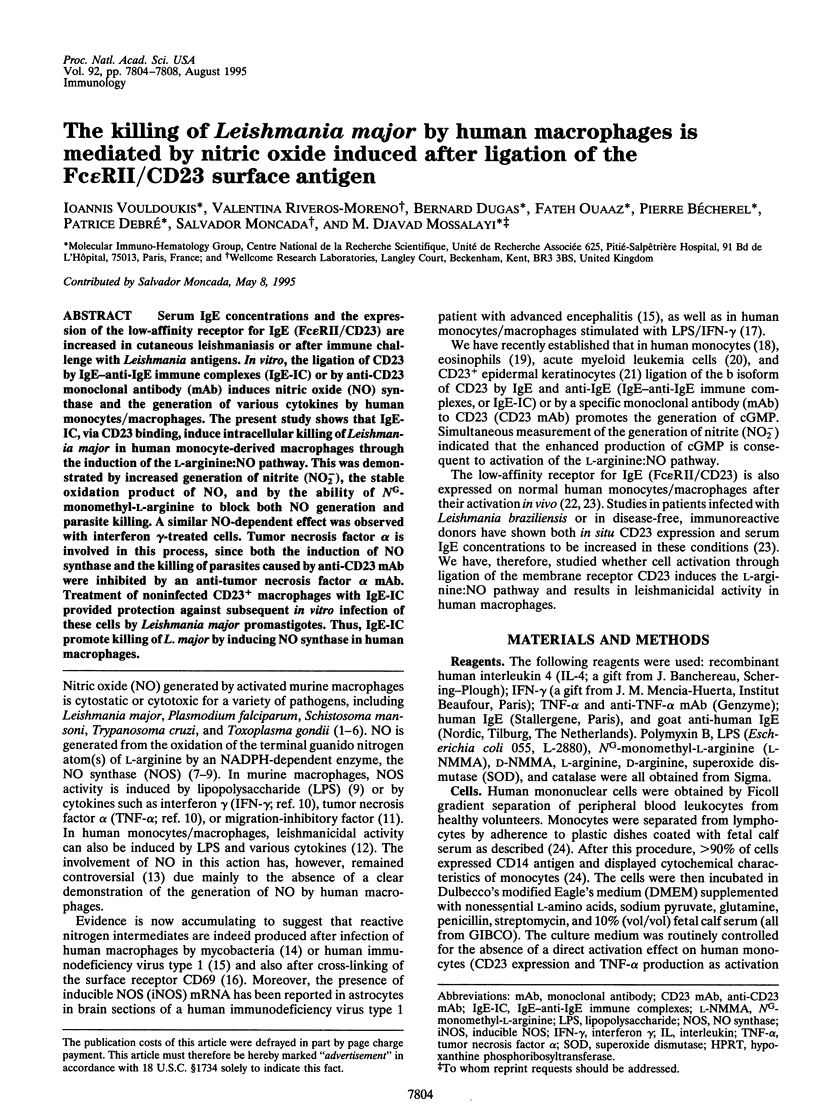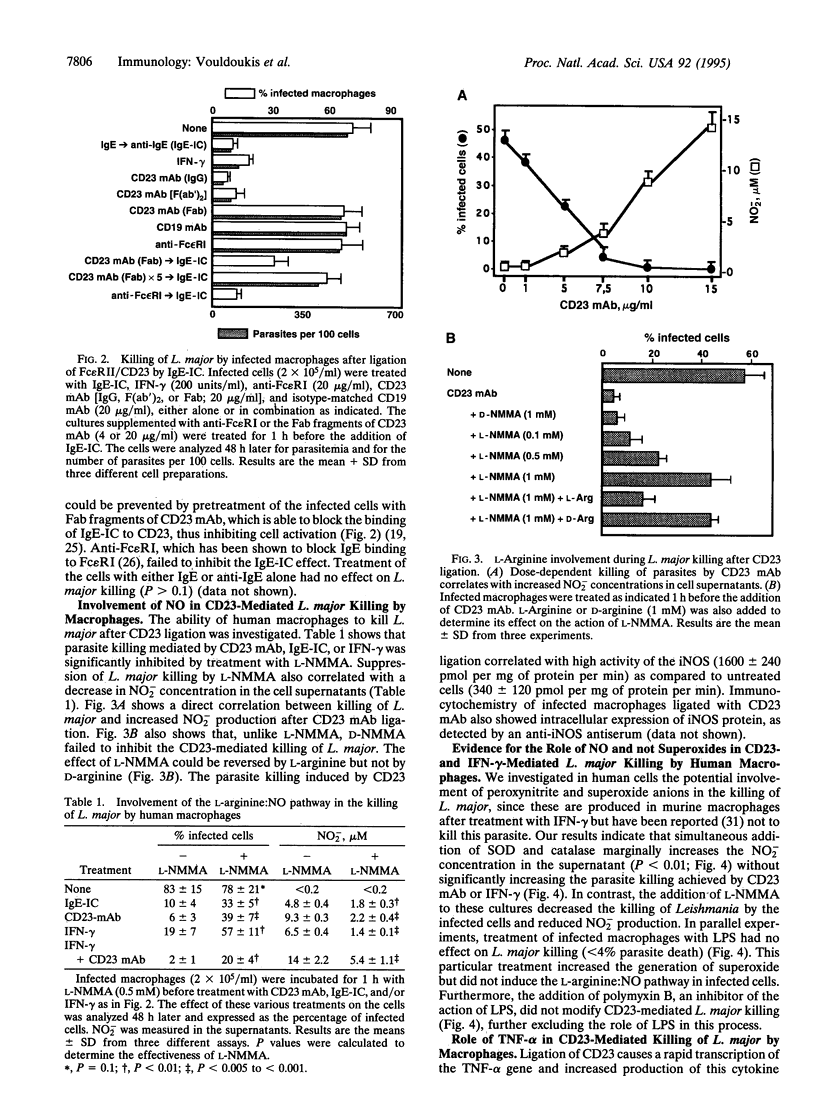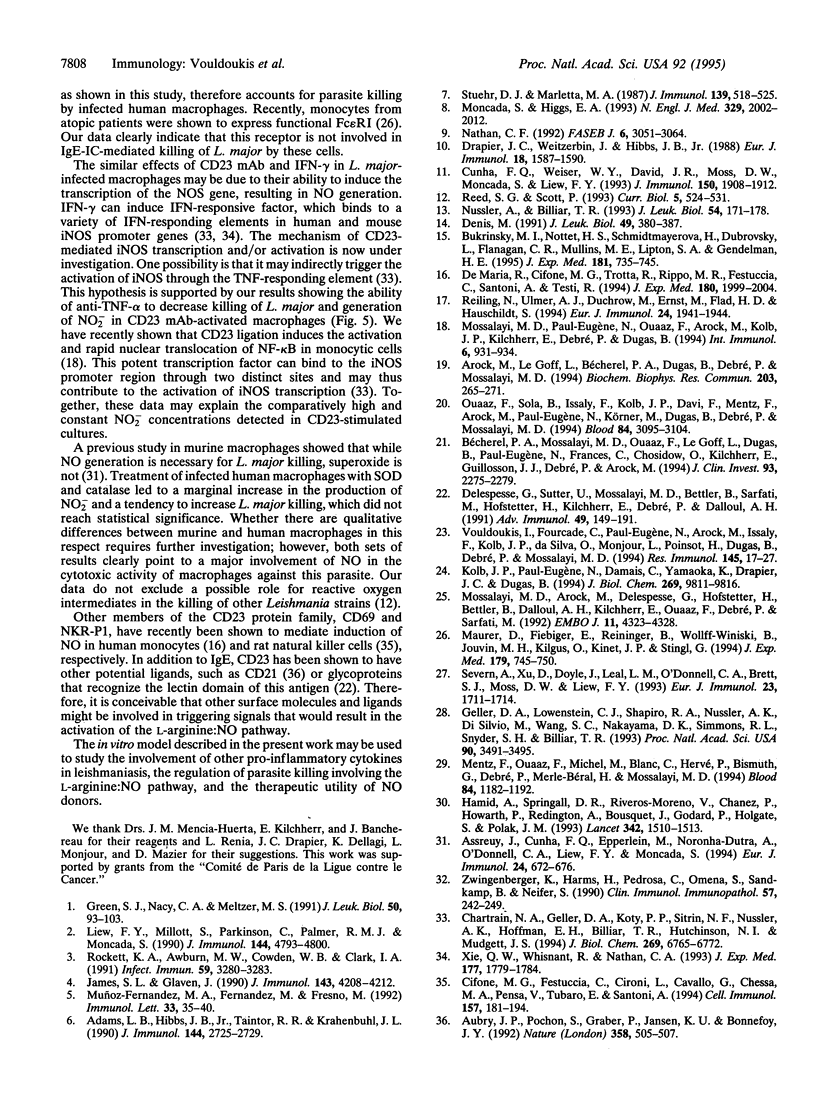Abstract
Serum IgE concentrations and the expression of the low-affinity receptor for IgE (Fc epsilon RII/CD23) are increased in cutaneous leishmaniasis or after immune challenge with Leishmania antigens. In vitro, the ligation of CD23 by IgE-anti-IgE immune complexes (IgE-IC) or by anti-CD23 monoclonal antibody (mAb) induces nitric oxide (NO) synthase and the generation of various cytokines by human monocytes/macrophages. The present study shows that IgE-IC, via CD23 binding, induce intracellular killing of Leishmania major in human monocyte-derived macrophages through the induction of the L-arginine:NO pathway. This was demonstrated by increased generation of nitrite (NO2-), the stable oxidation product of NO, and by the ability of NG-monomethyl-L-arginine to block both NO generation and parasite killing. A similar NO-dependent effect was observed with interferon gamma-treated cells. Tumor necrosis factor alpha is involved in this process, since both the induction of NO synthase and the killing of parasites caused by anti-CD23 mAb were inhibited by an anti-tumor necrosis factor alpha mAb. Treatment of noninfected CD23+ macrophages with IgE-IC provided protection against subsequent in vitro infection of these cells by Leishmania major promastigotes. Thus, IgE-IC promote killing of L. major by inducing NO synthase in human macrophages.
Full text
PDF




Images in this article
Selected References
These references are in PubMed. This may not be the complete list of references from this article.
- Adams L. B., Hibbs J. B., Jr, Taintor R. R., Krahenbuhl J. L. Microbiostatic effect of murine-activated macrophages for Toxoplasma gondii. Role for synthesis of inorganic nitrogen oxides from L-arginine. J Immunol. 1990 Apr 1;144(7):2725–2729. [PubMed] [Google Scholar]
- Arock M., Le Goff L., Bécherel P. A., Dugas B., Debré P., Mossalayi M. D. Involvement of Fc epsilon RII/CD23 and L-arginine dependent pathway in IgE-mediated activation of human eosinophils. Biochem Biophys Res Commun. 1994 Aug 30;203(1):265–271. doi: 10.1006/bbrc.1994.2177. [DOI] [PubMed] [Google Scholar]
- Assreuy J., Cunha F. Q., Epperlein M., Noronha-Dutra A., O'Donnell C. A., Liew F. Y., Moncada S. Production of nitric oxide and superoxide by activated macrophages and killing of Leishmania major. Eur J Immunol. 1994 Mar;24(3):672–676. doi: 10.1002/eji.1830240328. [DOI] [PubMed] [Google Scholar]
- Aubry J. P., Pochon S., Graber P., Jansen K. U., Bonnefoy J. Y. CD21 is a ligand for CD23 and regulates IgE production. Nature. 1992 Aug 6;358(6386):505–507. doi: 10.1038/358505a0. [DOI] [PubMed] [Google Scholar]
- Bukrinsky M. I., Nottet H. S., Schmidtmayerova H., Dubrovsky L., Flanagan C. R., Mullins M. E., Lipton S. A., Gendelman H. E. Regulation of nitric oxide synthase activity in human immunodeficiency virus type 1 (HIV-1)-infected monocytes: implications for HIV-associated neurological disease. J Exp Med. 1995 Feb 1;181(2):735–745. doi: 10.1084/jem.181.2.735. [DOI] [PMC free article] [PubMed] [Google Scholar]
- Bécherel P. A., Mossalayi M. D., Ouaaz F., Le Goff L., Dugas B., Paul-Eugène N., Frances C., Chosidow O., Kilchherr E., Guillosson J. J. Involvement of cyclic AMP and nitric oxide in immunoglobulin E-dependent activation of Fc epsilon RII/CD23+ normal human keratinocytes. J Clin Invest. 1994 May;93(5):2275–2279. doi: 10.1172/JCI117227. [DOI] [PMC free article] [PubMed] [Google Scholar]
- Chartrain N. A., Geller D. A., Koty P. P., Sitrin N. F., Nussler A. K., Hoffman E. P., Billiar T. R., Hutchinson N. I., Mudgett J. S. Molecular cloning, structure, and chromosomal localization of the human inducible nitric oxide synthase gene. J Biol Chem. 1994 Mar 4;269(9):6765–6772. [PubMed] [Google Scholar]
- Cifone M. G., Festuccia C., Cironi L., Cavallo G., Chessa M. A., Pensa V., Tubaro E., Santoni A. Induction of the nitric oxide-synthesizing pathway in fresh and interleukin 2-cultured rat natural killer cells. Cell Immunol. 1994 Aug;157(1):181–194. doi: 10.1006/cimm.1994.1215. [DOI] [PubMed] [Google Scholar]
- Cunha F. Q., Weiser W. Y., David J. R., Moss D. W., Moncada S., Liew F. Y. Recombinant migration inhibitory factor induces nitric oxide synthase in murine macrophages. J Immunol. 1993 Mar 1;150(5):1908–1912. [PubMed] [Google Scholar]
- De Maria R., Cifone M. G., Trotta R., Rippo M. R., Festuccia C., Santoni A., Testi R. Triggering of human monocyte activation through CD69, a member of the natural killer cell gene complex family of signal transducing receptors. J Exp Med. 1994 Nov 1;180(5):1999–2004. doi: 10.1084/jem.180.5.1999. [DOI] [PMC free article] [PubMed] [Google Scholar]
- Delespesse G., Suter U., Mossalayi D., Bettler B., Sarfati M., Hofstetter H., Kilcherr E., Debre P., Dalloul A. Expression, structure, and function of the CD23 antigen. Adv Immunol. 1991;49:149–191. doi: 10.1016/s0065-2776(08)60776-2. [DOI] [PubMed] [Google Scholar]
- Denis M. Tumor necrosis factor and granulocyte macrophage-colony stimulating factor stimulate human macrophages to restrict growth of virulent Mycobacterium avium and to kill avirulent M. avium: killing effector mechanism depends on the generation of reactive nitrogen intermediates. J Leukoc Biol. 1991 Apr;49(4):380–387. doi: 10.1002/jlb.49.4.380. [DOI] [PubMed] [Google Scholar]
- Drapier J. C., Wietzerbin J., Hibbs J. B., Jr Interferon-gamma and tumor necrosis factor induce the L-arginine-dependent cytotoxic effector mechanism in murine macrophages. Eur J Immunol. 1988 Oct;18(10):1587–1592. doi: 10.1002/eji.1830181018. [DOI] [PubMed] [Google Scholar]
- Geller D. A., Lowenstein C. J., Shapiro R. A., Nussler A. K., Di Silvio M., Wang S. C., Nakayama D. K., Simmons R. L., Snyder S. H., Billiar T. R. Molecular cloning and expression of inducible nitric oxide synthase from human hepatocytes. Proc Natl Acad Sci U S A. 1993 Apr 15;90(8):3491–3495. doi: 10.1073/pnas.90.8.3491. [DOI] [PMC free article] [PubMed] [Google Scholar]
- Green S. J., Nacy C. A., Meltzer M. S. Cytokine-induced synthesis of nitrogen oxides in macrophages: a protective host response to Leishmania and other intracellular pathogens. J Leukoc Biol. 1991 Jul;50(1):93–103. doi: 10.1002/jlb.50.1.93. [DOI] [PubMed] [Google Scholar]
- Hamid Q., Springall D. R., Riveros-Moreno V., Chanez P., Howarth P., Redington A., Bousquet J., Godard P., Holgate S., Polak J. M. Induction of nitric oxide synthase in asthma. Lancet. 1993 Dec 18;342(8886-8887):1510–1513. doi: 10.1016/s0140-6736(05)80083-2. [DOI] [PubMed] [Google Scholar]
- James S. L., Glaven J. Macrophage cytotoxicity against schistosomula of Schistosoma mansoni involves arginine-dependent production of reactive nitrogen intermediates. J Immunol. 1989 Dec 15;143(12):4208–4212. [PubMed] [Google Scholar]
- Kolb J. P., Paul-Eugene N., Damais C., Yamaoka K., Drapier J. C., Dugas B. Interleukin-4 stimulates cGMP production by IFN-gamma-activated human monocytes. Involvement of the nitric oxide synthase pathway. J Biol Chem. 1994 Apr 1;269(13):9811–9816. [PubMed] [Google Scholar]
- Maurer D., Fiebiger E., Reininger B., Wolff-Winiski B., Jouvin M. H., Kilgus O., Kinet J. P., Stingl G. Expression of functional high affinity immunoglobulin E receptors (Fc epsilon RI) on monocytes of atopic individuals. J Exp Med. 1994 Feb 1;179(2):745–750. doi: 10.1084/jem.179.2.745. [DOI] [PMC free article] [PubMed] [Google Scholar]
- Mentz F., Ouaaz F., Michel A., Blanc C., Hervé P., Bismuth G., Debré P., Merle-Béral H., Mossalayi M. D. Maturation of acute T-lymphoblastic leukemia cells after CD2 ligation and subsequent treatment with interleukin-2. Blood. 1994 Aug 15;84(4):1182–1192. [PubMed] [Google Scholar]
- Moncada S., Higgs A. The L-arginine-nitric oxide pathway. N Engl J Med. 1993 Dec 30;329(27):2002–2012. doi: 10.1056/NEJM199312303292706. [DOI] [PubMed] [Google Scholar]
- Mossalayi M. D., Arock M., Delespesse G., Hofstetter H., Bettler B., Dalloul A. H., Kilchherr E., Quaaz F., Debré P., Sarfati M. Cytokine effects of CD23 are mediated by an epitope distinct from the IgE binding site. EMBO J. 1992 Dec;11(12):4323–4328. doi: 10.1002/j.1460-2075.1992.tb05531.x. [DOI] [PMC free article] [PubMed] [Google Scholar]
- Mossalayi M. D., Paul-Eugène N., Ouaaz F., Arock M., Kolb J. P., Kilchherr E., Debré P., Dugas B. Involvement of Fc epsilon RII/CD23 and L-arginine-dependent pathway in IgE-mediated stimulation of human monocyte functions. Int Immunol. 1994 Jul;6(7):931–934. doi: 10.1093/intimm/6.7.931. [DOI] [PubMed] [Google Scholar]
- Muñoz-Fernández M. A., Fernández M. A., Fresno M. Activation of human macrophages for the killing of intracellular Trypanosoma cruzi by TNF-alpha and IFN-gamma through a nitric oxide-dependent mechanism. Immunol Lett. 1992 Jun;33(1):35–40. doi: 10.1016/0165-2478(92)90090-b. [DOI] [PubMed] [Google Scholar]
- Nathan C. Nitric oxide as a secretory product of mammalian cells. FASEB J. 1992 Sep;6(12):3051–3064. [PubMed] [Google Scholar]
- Nussler A. K., Billiar T. R. Inflammation, immunoregulation, and inducible nitric oxide synthase. J Leukoc Biol. 1993 Aug;54(2):171–178. [PubMed] [Google Scholar]
- Ouaaz F., Sola B., Issaly F., Kolb J. P., Davi F., Mentz F., Arock M., Paul-Eugène N., Körner M., Dugas B. Growth arrest and terminal differentiation of leukemic myelomonocytic cells induced through ligation of surface CD23 antigen. Blood. 1994 Nov 1;84(9):3095–3104. [PubMed] [Google Scholar]
- Reed S. G., Scott P. T-cell and cytokine responses in leishmaniasis. Curr Opin Immunol. 1993 Aug;5(4):524–531. doi: 10.1016/0952-7915(93)90033-o. [DOI] [PubMed] [Google Scholar]
- Reiling N., Ulmer A. J., Duchrow M., Ernst M., Flad H. D., Hauschildt S. Nitric oxide synthase: mRNA expression of different isoforms in human monocytes/macrophages. Eur J Immunol. 1994 Aug;24(8):1941–1944. doi: 10.1002/eji.1830240836. [DOI] [PubMed] [Google Scholar]
- Rockett K. A., Awburn M. M., Cowden W. B., Clark I. A. Killing of Plasmodium falciparum in vitro by nitric oxide derivatives. Infect Immun. 1991 Sep;59(9):3280–3283. doi: 10.1128/iai.59.9.3280-3283.1991. [DOI] [PMC free article] [PubMed] [Google Scholar]
- Severn A., Xu D., Doyle J., Leal L. M., O'Donnell C. A., Brett S. J., Moss D. W., Liew F. Y. Pre-exposure of murine macrophages to lipopolysaccharide inhibits the induction of nitric oxide synthase and reduces leishmanicidal activity. Eur J Immunol. 1993 Jul;23(7):1711–1714. doi: 10.1002/eji.1830230747. [DOI] [PubMed] [Google Scholar]
- Stuehr D. J., Marletta M. A. Induction of nitrite/nitrate synthesis in murine macrophages by BCG infection, lymphokines, or interferon-gamma. J Immunol. 1987 Jul 15;139(2):518–525. [PubMed] [Google Scholar]
- Vouldoukis I., Issaly F., Fourcade C., Paul-Eugène N., Arock M., Kolb J. P., da Silva O. A., Monjour L., Poinsot H., Tselentis Y. CD23 and IgE expression during the human immune response to cutaneous leishmaniasis: possible role in monocyte activation. Res Immunol. 1994 Jan;145(1):17–27. doi: 10.1016/s0923-2494(94)80037-5. [DOI] [PubMed] [Google Scholar]
- Xie Q. W., Whisnant R., Nathan C. Promoter of the mouse gene encoding calcium-independent nitric oxide synthase confers inducibility by interferon gamma and bacterial lipopolysaccharide. J Exp Med. 1993 Jun 1;177(6):1779–1784. doi: 10.1084/jem.177.6.1779. [DOI] [PMC free article] [PubMed] [Google Scholar]
- Zwingenberger K., Harms G., Pedrosa C., Omena S., Sandkamp B., Neifer S. Determinants of the immune response in visceral leishmaniasis: evidence for predominance of endogenous interleukin 4 over interferon-gamma production. Clin Immunol Immunopathol. 1990 Nov;57(2):242–249. doi: 10.1016/0090-1229(90)90038-r. [DOI] [PubMed] [Google Scholar]




